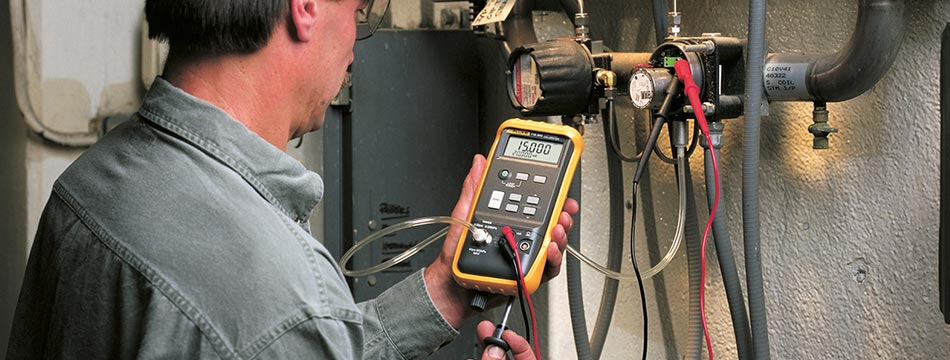
Pressure calibrators may be handheld or bench instruments that contain pressure pumps and transducers internally or externally, and can measure and/or generate voltage, current and temperature.
For example, in a pressure calibrator with internal pump, the pressure gauge is connected to the output of the pressure calibrator. Attention must be given to the connections’ tightness in order to avoid leakages which will affect the measurement result.
Before calibration, an initial check must determine the pressure gauge’s condition. It needs to be brought at least twice to its upper pressure limit and the pressure kept for at least one minute. During the first pressure rise, the indication obtained must be checked out for conformity with specifications. The gauge indications must be read at 0%, 50% and 100% of its measurement span.
Calibration is performed once at six pressure points spread over the measuring span of the gauge at increasing and decreasing pressures. Repeatability is estimated from three repeated measurements at one pressure point, preferably at 50% of full scale.
At each pressure point, data recorded includes, the pressure indicated by the reference instrument, the indication of the instrument under test, temperature and atmospheric pressure values, the identification parameters of the instrument under test and the identification of the instruments included in the measuring system.
Choice of pressure calibrator
As for choice of pressure calibrator, these start from below £1,000 for a Fluke 717 Pressure Calibrator to just over £2,500 for Fluke 718Ex Intrinsically Safe Pressure Calibrator. For the purpose of this article, we will focus on three midrange pressure calibrators from CALOG, Beamex and Fluke.
The CALOG Pressure Calibrator measures up to 700 bar of pressure and can be used to measure current and voltage up to 24mA and 32V, while an SD card is included for enhanced computer connectivity. It can also measure resistance, with an audible continuity signal on values of less than 100 ohms.
It is operated by using 11 soft-touch buttons located at the front of the instrument, and probes are connected to the top panel. This handheld calibrator has an LCD screen with backlight for visibility in all working conditions.
The SD card allows storage for transferring data to a computer without the need for a USB cable. An automatic shutdown feature can be customised to suit individual users, while a pressure conversion calculator allows measurement in different units. The lithium ion battery provides around eight hours of battery life.
The Beamex MC2-PE Pressure/Electrical Calibrator is a hand held portable field calibrator with a large graphical display for ease of use in harsh environments. A menu based interface allows for simple operation even for complex calibration tasks, and the calibrator comes with a full numerical keyboard for easy data entry.
Industrial applications for plant maintenance engineers and technicians include pharmaceutical plants, food and beverage plants, power plants, service companies and oil, gas and petrochemical plants and refineries. There are five individual internal pressure modules available, and up to eighteen different external modules, all of which are plug-and-play.
The MC2-PE features a pressure section with internal pressure module, connection for external pressure modules, and positive, negative and absolute pressure; and an electrical section with internal 24V DC loop supply, current measurement, voltage measurement, frequency measurement, pulse counting and switch testing.
The MC2-PE supports current measurement using either its own loop power supply while at the same time measuring the current, or simply measuring the current while an external power supply is used.
HART compatibility
It is also advisable to check the HART Compatible Loop Supply setting if the MC2-PE is used as the power supply. When the option is checked it adds suitable impedance to the loop to ensure HART communication.
The Fluke 718 Pressure Calibrator is available with a selection of pressure configuration options, providing all the functions needed to calibrate transmitters, gauges and switches to perform pressure sourcing and milliamp measurements. It is also compatible with 29 pressure modules which are part of Fluke's 700 series.
An integrated pump makes it easy to clean out the tester should it be accidentally exposed to fluids. The pump uses protective check valves that allow air to pass through the pump but stops liquids, significantly reducing the chances of accidental liquid seepage.
Even after draining the process fluid from the calibration port of the device under test, minute amounts of process fluid often remain behind. In the event these fluids enter the 718 pump cavities, the new pump design enables quick cleaning and maintenance, even in the field.
Featuring mA accuracy of 0.015%, MIN/MAX functions calculate the maximum or minimum values taken over a time period, while a data hold function temporarily freezes the last value taken on the screen. A switch test feature allows for quicker and more accurate pressure switch testing.
Conclusion
Manufacturing plants need to be absolutely confident that their temperature sensors, pressure transducers, flow meters and the like, are measuring to specified tolerances. If sensors drift out of their specification range, the consequences can be disastrous for a plant, resulting in costly production downtime and safety issues.
Calibration frequency should be increased if the sensor has drifted outside of its specified tolerances during a given time period and if the sensor is located in a critical process or area of the plant and has drifted significantly compared to its specified tolerance over a given time period.
For further information please visit Pressure Calibrators & Controllers web page and calibrate.co.uk.


